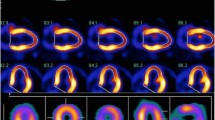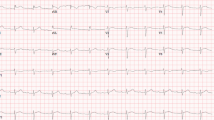Abstract
Background. The precise etiology of takotsubo cardiomyopathy remains unclear. The study of myocardial blood flow (MBF) and coronary flow reserve (CFR) by use of positron emission tomography might help in understanding this syndrome.
Methods and Results. Three postmenopausal women underwent adenosine/rest perfusion with nitrogen 13 ammonia and metabolism with fluorine 18 fluorodeoxyglucose positron emission tomography, coronary angiography, cardiac magnetic resonance, and echocardiography in the acute phase of takotsubo cardiomyopathy and at 3 months’ follow-up, after normalization of left ventricular function. PET study was performed in 2 parts: the perfusion analysis with nitrogen ammonia and the metabolism of the heart using FDG. MBF and CFR were analyzed quantitatively in the acute phase and at follow-up. The images highlighted the impairment of tissue metabolism in the dysfunctioning left ventricular segments in the acute phase, mainly in the apical segments and progressively less in the medium segments. At the same time, a clear inverse metabolic/perfusion mismatch emerged, which normalized 3 months later. The quantitative analysis of MBF showed a reduction in the acute phase in apical segments in comparison to basal segments without differences between midventricular and basal segments. In the acute phase CFR proved to be reduced in apical versus basal segments. CFR impairment of apical segments recovered completely after 3 months.
Conclusion. The acute phase of takotsubo cardiomyopathy is characterized by an inverse perfusion/metabolism mismatch with a reduction in CFR in the apical segments. However, the impairment of CFR and the reduction of metabolism in the apical segments recovered completely after 3 months.
Similar content being viewed by others
References
Bybee KA, Kara T, Prasad A, Lerman A, Barsness GW, Wright RS, et al. Systematic review: Transient left ventricular apical ballooning: A syndrome that mimics ST-segment elevation myocardial infarction. Ann Intern Med 2004;141:858–65.
Abe Y, Kondo M, Matsuoka R, Araki M, Dohyama K, Tanio H. Assessment of clinical features in transient left ventricular apical ballooning. J Am Coll Cardiol 2003;41:737–42.
Dote K, Sato H, Tateishi H, Uchida T, Ishihara M. Myocardial stunning due to simultaneous multivessel coronary spasms: A review of 5 cases [in Japanese]. J Cardiol 1991;21:203–14.
Schelbert HR, Phelps ME, Hoffman EJ, Huang SC, Selin CE, Kuhl DE. Regional myocardial perfusion assessed with N-13 labeled ammonia and positron emission computerized axial tomography. Am J Cardiol 1979;43:209–18.
Schelbert HR, Phelps ME, Huang SC, MacDonald NS, Hansen H, Selin C, et al. N-13 ammonia as an indicator of myocardial blood flow. Circulation 1981;63:1259–72.
Bellina CR, Parodi O, Camici P, Salvadori PA, Taddei L, Fusani L, et al. Simultaneous in vitro and in vivo validation of nitrogen-13-ammonia for the assessment of regional myocardial blood flow. J Nucl Med 1990;31:1335–43.
Hutchins GD, Schwaiger M, Rosenspire KC, Krivokapich J, Schelbert H, Kuhl DE. Noninvasive quantification of regional blood flow in the human heart using N-13 ammonia and dynamic positron emission tomographic imaging. J Am Coll Cardiol 1990;15:1032–42.
Krivokapich J, Smith GT, Huang SC, Hoffman EJ, Ratib O, Phelps ME, et al. 13N ammonia myocardial imaging at rest and with exercise in normal volunteers: Quantification of absolute myocardial perfusion with dynamic positron emission tomography. Circulation 1989;80:1328–37.
Muzik O, Beanlands RS, Hutchins GD, Manger TJ, Nguyen N, Schwaiger M. Validation of nitrogen-13-ammonia tracer kinetic model for quantification of myocardial blood flow using PET. J Nucl Med 1993;34:83–91.
Rimoldi OE, Camici PG. Positron emission tomography for quantitation of myocardial perfusion. J Nucl Cardiol 2004;11:482–90.
Camici PG. Positron emission tomography and myocardial imaging. Heart 2000;83:475–80.
Feola M, Rosso GL, Casasso F, Morena L, Biggi A, Chauvie S, et al. “Reversible inverse-mismatch“ in transient left ventricular apical ballooning: Perfusion/metabolism positron emission tomography imaging. J Nucl Cardiol 2006;13:587–90.
Alexanderson E, Cruz P, Talayero JA, Damas F, Zeron J, Meave A. Transient perfusion and motion abnormalities in takotsubo cardiomyopathy. J Nucl Cardiol 2007;14:129–33.
DeFronzo RA, Tobin JD, Andres R. Glucose clamp technique: A method for quantifying insulin secretion and resistance. Am J Physiol 1979;273:E214–23.
DeGrado TR, Hanson MW, Turkington TG, Delong DM, Brezinski DA, Vallee JP, et al. Estimation of myocardial blood flow for longitudinal studies with N13-labeled ammonia and positron emission tomography. J Nucl Cardiol 1996;3:494–507.
Kim RJ, Wu E, Rafael A, Chen EL, Parker MA, Simonetti O, et al. The use of contrast-enhanced magnetic resonance imaging to identify reversible myocardial dysfunction. N Engl J Med 2000;343:1445–53.
Mori H, Ishikawa S, Kojima S, Hayashi J, Watanabe Y, Hoffman JI, et al. Increased responsiveness of left ventricular apical myocardium to adrenergic stimuli. Cardiovasc Res 1993;27:192–8.
Scholte AJH, Bax JJ, Stokkel MP, Plokker T, Kaandorp AM, Lamb HJ, et al. Multimodality imaging to diagnose takotsubo cardiomyopathy. J Nucl Cardiol 2006;13:123–6.
Malafronte C, Farina A, Tempesta A, Lobiati E, Galbiati R, Cantù E, et al. Tako-tsubo: A transitory impairment of microcirculation? A case report. Ital Heart J 2005;6:933–8.
Nef HM, Mollmann H, Elsasser A. Tako-tsubo cardiomyopathy (apical ballooning). Heart 2007;93:1309–15.
Gianni M, Dentali F, Grandi AM, Sumner G, Hiralal R, Lonn E. Apical ballooning syndrome or takotsubo cardiomyopathy: A systematic review. Eur Heart J 2007;27:1523–29.
Sadamatsu K, Tashiro H, Maehira N, Yamamoto K. Coronary microvascular abnormality in reversible systolic dysfunction observed after noncardiac disease. Jpn Circ 2000;64:789–92.
Ako J, Takenaka K, Uno K, Nakamura F, Shoji T, Iijmia K, et al. Reversible left ventricular systolic dysfunction-reversibility of coronary microvascular abnormality. Jpn Heart J 2001;42:355–63.
Hernandez-Pampaloni M, Keng FYJ, Kudo T, Sayre JS, Schelbert HR. Abnormal longitudinal, base-to-apex myocardial perfusion gradient by quantitative blood flow measurements in patients with coronary risk factors. Circulation 2001;104:527–32.
Camici PG, Crea F. Coronary microvascular dysfunction. N Engl J Med 2007;356:830–40.
Kaufmann PA, Gnecchi-Ruscone T, di Terlizzi M, Schafers KP, Lusher TF, Camici PG. Coronary artery disease in smokers: Vitamin C restores coronary microcirculatory function. Circulation 2000;102:1233–8.
Kaufmann PA, Gnechhi-Ruscone T, Schafers KP, Lusher TF, Camici PG. LDL and coronary microvascular dysfunction in hypercholesterolemia. J Am Coll Cardiol 2000;36:103–9.
Author information
Authors and Affiliations
Corresponding author
Rights and permissions
About this article
Cite this article
Feola, M., Chauvie, S., Rosso, G.L. et al. Reversible impairment of coronary flow reserve in takotsubo cardiomyopathy: A myocardial PET study. J Nucl Cardiol 15, 811–817 (2008). https://doi.org/10.1007/BF03007363
Received:
Revised:
Issue Date:
DOI: https://doi.org/10.1007/BF03007363




